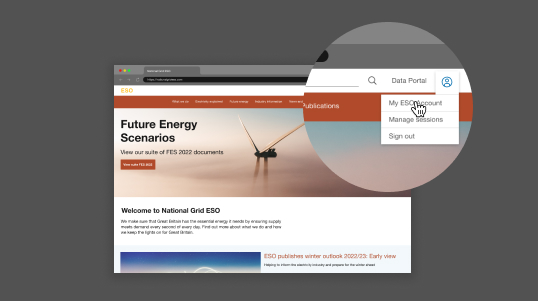The Electricity National Control Centre operates GB’s electricity system in real time.
Every day, ESO experts at the Electricity National Control Centre (ENCC) work around the clock to balance supply and demand, make decisions on who provides electricity at any given time and collaborate with network operators across the system.
Our licence obligations
At the ESO, we have a licence provided by Ofgem and a requirement to operate a safe, reliable and efficient network. As such, we have a set of standards that the ENCC must meet. Our regulation means that we focus on continuation of service, using the cheapest power available on the system at any given time. Put simply, we are agnostic to the type of generation running – however, we do look to report on the carbon impact of what is running.
As part of our licence, we’re required to plan, develop and operate the National Electricity Transmission System (NETS) in accordance with the System Security and Quality of Supply Standard (SQSS). With unforeseen events, such as a lightning strike and generation loss, we need to achieve a balance between holding lots of “backup” power – which is costly and ultimately has to be paid for by the consumer – while also maintaining reliability of supply and covering for risk. The SSQS dictates the amount of “backup” power the ESO holds. This amount is currently calculated as the largest infeed to the system at any time.
The ESO is also required under its licence to comply with the Grid Code, which is the technical code for connection and development of the NETS. This sets out the detailed operating procedures and principles that govern the relationship and interactions between the ESO and users of the NETS, such as generators and other users.
Under these requirements, the ENCC has two key functions – forecasting and managing the flow of energy and balancing supply and demand on a second-by-second basis. Together, these roles make sure that electricity is provided across the network in a way that is as timely, reliable and affordable as possible.
GB’s transmission network
Before exploring the ENCC’s demand forecasting and balancing functions, it’s important to understand the ESO’s role within GB’s transmission network.
The transmission system is the physical infrastructure used to move electricity around the system – think towers, pylons and electricity lines. The ESO does not own or maintain any transmission assets. Instead, these are owned by Transmission Owners (TOs).
In Great Britain, we have national and local transmission networks. National networks are like a motorway, while the local transmission networks are like the diverging smaller roads. The ESO operates the national part of the system. Once electricity arrives at local networks, Distribution Network Operators (DNOs) take it to consumers.
There are two types of generation on the transmission network – transmission-connected generation and embedded generation. The ENCC can see connected generation, but not embedded generation, which is embedded in the local networks. This means that to understand GB’s electricity demand, we need to have a view and forecast wind, solar and other local generation types that aren’t visible on the national network.
To do this, the ENCC conducts close to real-time demand forecasting to predict the minute-by-minute demand changes that will occur on the transmission network. Putting this demand forecast alongside the generation available helps us to manage the system and balance both sides.
The ENCC’s demand forecasting team works to understand the bigger picture. They use complex forecasting models to predict exactly how much electricity will be needed, where it’s needed and when.
This involves looking at weather patterns, like how much sun is shining or where wind is blowing. We use a real-time feedback system to measure these patterns.
We also work to predict consumer behaviour, like whether families will head outdoors for a sunny bank holiday weekend or stay inside on a cold winter night. We even predict peaks in TV turn-on during events like the Euro 2020 Final. These predictions show us when demand will rise and fall.
Of course, weather patterns and consumer demand can be challenging to forecast. Sometimes our demand forecasters use historic curves – which show the demand in previous years – to predict patterns. We can use these trends to understand what to expect during certain times of the year. Other ENCC specialists even model space weather looking to see the impact of solar radiation on earth’s electricity networks.
On a longer-term scale, the ESO also works to predict upcoming seasonal trends. Not to be confused with the ENCC’s demand forecasting, our Summer Outlook and Winter Outlook teams work months ahead to model the coming seasonal shifts in electricity supply and demand, giving industry a view to help their planning activities.
The ENCC’s balancing experts make sure that electricity supply meets demand. They fine-tune the electricity available on the system in real time, using predictions from our demand forecasts to supply electricity.
To balance supply and demand, we need to keep the system frequency as close to 50 Hertz (Hz) – the frequency at which the UK’s devices operate – as possible. The ENCC monitors frequency in real time, troubleshooting what they see on the system. If demand rises, we ask operators to ramp up generation otherwise the frequency falls. If demand drops, we ask operators to reduce generation otherwise the frequency rises. If a generator or interconnector trips, that’s an immediate loss in generation – causing the frequency to fall. In this case, we activate reserve, which is our contingency or backup generation, to keep the frequency stable.
The ENCC has a range of unique tools needed to strike this balance, from Dynamic Response and Reserve to the Balancing Mechanism (BM). Our main tool – the BM – is the way by which the ESO makes sure there’s enough electricity on the system. We use the BM to buy changes in generation and consumption when a mismatch needs correcting. Unlike balancing services such as short term operating reserve (STOR) the BM is an almost real time market with highly dynamic prices.
Our job is to look at data coming into the BM. In this case, that data includes bids and offers – which are the prices to change the output of electricity providers – submitted by generators, providers and market industry participants. Every half hour, the BM opens to new bids and offers, allowing participants to submit prices for how much it would cost the ESO to get more or less electricity to meet the demand.
Using this data alongside our demand predictions, the ENCC’s balancing team assesses what is available on the electricity system. We then instruct parties to deliver that electricity for the next 30-minute dispatch period, taking the most cost-effective option from the BM bid and offer data.

